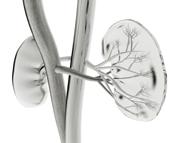Advertisment
BTS 2013 Report – When one is not enough: dual kidney transplantation

by Maria Dalby reporting on the presentation by Lucrezia Furian, University of Padova, Italy. Donors are getting older and the quality of organs offered to centres for transplantation is dwindling. In kidney transplantation, one alternative is to perform a dual kidney transplantation to compensate for the compromised quality.
Professor Lucrezia Furian is a transplant surgeon at Italy’s leading transplant centre in Padova the north of Italy. In a session dedicated to all aspects of marginal donors, Professor Furian outlined the challenges surrounding dual kidney transplantation (DKT) at the Padova centre and the results achieved at the centre over a 10-year period.
Dramatic changes in the quality of organs available for donation in the last 10-15 years have meant that older donors are no longer regarded as extended-criteria donors in northern Italy – over 50% of donors at the Padova centre are aged over 60 years. The DKT procedure was first described in 1996 by a team at Stanford University in the US (1). Since then, a protocol has been developed for performing DKT in routine practice (2). In the period from 2000 to 2009 a total of 13,300 kidney transplants were performed in Italy, 839 of which (6.2%) were DKTs, with patient and graft survival rates very close to those seen for the kidney transplant population as a whole.
DKT is now widely performed in Italy – 10 of 14 transplant centres have joined the DKT programme. When evaluating donors aged 60 years and over, the protocol used at the Padova centre involves performing a renal biopsy for donors who present with clinical risk factors such as impaired creatinine clearance, proteinuria, severe hypertension, diabetes, or a history of stroke or myocardial infarction. Donors aged 70 years and over are regarded as high risk and are biopsied routinely. The biopsy sampling mode is an area of debate; an Italian study published in 2010 concluded that a needle core biopsy provides the best representation of the kidney as a whole and is more reliable than the wedge technique (3).
On the histological evaluation, Professor Furian also stressed the importance of taking into account both the degree of glomerulosclerosis and the presence of vascular lesions, as the latter are regarded as more predictive of the transplant outcome (4). At the Padova centre the so-called Remuzzi score has been used for around 10 years, which assesses glomerular sclerosis, tubular atrophy, interstitial fibrosis and arterial/arteriolar narrowing on a 4-grade scale and assigned a final damage score, where kidneys between 0 and 3 are used for single kidney transplants, score 4-6 kidneys are used for DKT, and scores of 7 and over are discarded. One limitation of this score is the differences between individual pathologists which may be considerable (5).
As far as the recipient is concerned, the protocol used at Padova includes a series of contraindications, including age below 55 years, re-transplantation, polycystic kidneys, bladder reconstructions, and importantly, patients living at a long distance from the transplant centre. The surgical technique used for the DKT involves transplanting the two kidneys next to one another with separate urethral anastomoses, which allows the operation to be performed in shorter time and leaves the contralateral iliac fossa free. Disadvantages of the unilateral approach includes the risk of compression of the lower kidney and of iliac vessel (6). The immunosuppressive protocol involves induction therapy to minimise nephrotoxicity in the early phase.
A total of 194 DKTs have been performed at Padova to date, with a follow-up period of 65 months. Professor Furian pointed out that the rates of delayed graft function (29.4%) and acute rejection (12.3%) must be considered good given the nature of the donors and recipients. Death-censored graft survival at 10 years is 93%, and renal function largely normal. Professor Furian concluded that although some aspects remain to be optimised, chiefly with respect to donor and recipient selection, DKT is a technique that offers excellent outcomes in the long and short term and should be considered as a means of expanding the donor pool.
1. Lee CM, Scandling JD, Pavlakis M, Markezich AJ, Dafoe DC, Alfrey EJ. A review of the kidneys that nobody wanted: determinants of optimal outcome. Transplantation. 1998;65(2):213-9. Epub 1998/02/11.
2. Remuzzi G, Grinyo J, Ruggenenti P, Beatini M, Cole EH, Milford EL, et al. Early experience with dual kidney transplantation in adults using expanded donor criteria. Double Kidney Transplant Group (DKG). Journal of the American Society of Nephrology : JASN. 1999;10(12):2591-8. Epub 1999/12/10.
3. Mazzucco G, Magnani C, Fortunato M, Todesco A, Monga G. The reliability of pre-transplant donor renal biopsies (PTDB) in predicting the kidney state. A comparative single-centre study on 154 untransplanted kidneys. Nephrology, dialysis, transplantation : official publication of the European Dialysis and Transplant Association – European Renal Association. 2010;25(10):3401-8. Epub 2010/04/02.
4. Woestenburg A, Sennesael J, Bosmans JL, Verbeelen D. Vasculopathy in the kidney allograft at time of transplantation: impact on later function of the graft. Transplantation. 2008;85(7 Suppl):S10-8. Epub 2008/05/24.
5. Fernandez-Lorente L, Riera L, Bestard O, Carrera M, Goma M, Porta N, et al. Long-term results of biopsy-guided selection and allocation of kidneys from older donors in older recipients. American journal of transplantation : official journal of the American Society of Transplantation and the American Society of Transplant Surgeons. 2012;12(10):2781-8. Epub 2012/06/19.
6. Ekser B, Furian L, Broggiato A, Silvestre C, Pierobon ES, Baldan N, et al. Technical aspects of unilateral dual kidney transplantation from expanded criteria donors: experience of 100 patients. American journal of transplantation : official journal of the American Society of Transplantation and the American Society of Transplant Surgeons. 2010;10(9):2000-7. Epub 2010/07/20.





